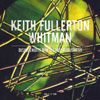 Just as good, if not better than, his Kranky output, Keith Fullerton Whitman's latest full-length is a prismatic burst of field recordings, tape manipulation, and synth wrangling via Pierre Henry and Kraftwerk. Disappearing behind elaborate electronic processes, Keith gives in to chance and lets his machines churn out two side-long pieces of frequency manipulation, helicopter rhythms, runaway melodies, and plenty of noise. Few things released last year are as thrilling as side two is: the five years Keith put into hatching it definitely paid off.
Just as good, if not better than, his Kranky output, Keith Fullerton Whitman's latest full-length is a prismatic burst of field recordings, tape manipulation, and synth wrangling via Pierre Henry and Kraftwerk. Disappearing behind elaborate electronic processes, Keith gives in to chance and lets his machines churn out two side-long pieces of frequency manipulation, helicopter rhythms, runaway melodies, and plenty of noise. Few things released last year are as thrilling as side two is: the five years Keith put into hatching it definitely paid off.
Keith's description of this record at Mimaroglu reads like a technical manual for aspiring composers, but it serves as an excellent introduction to the music. Utilizing a Nagra mono tape recorder, contact mics, modular synth, his own live recordings, and other varied gadgets and processes about which I know very little, Whitman pieces together a coherent half-hour of haphazard, absolutely electric audio in tribute to his favorite aleatoric and automatic sounds.
Anyone who has been to his live shows in the last couple of years will be familiar with Keith's modus operandi, at least in part. Nearly all of the first side's frequency burps, echoes, low-end rumbles, and reverberated voices are improvised into existence, not composed. Sounds happen, but they've been tied together in a knot. For a little while, the music is the sound of that knot coming undone. Voices, cars, street noise, metallic crashes, and a symphony of other vibrations collide with one another in accidental fashion until, around half-way through, the sensory overload gives way to patterns. Whether by accident or by design, clusters of acoustically-related noise are stretched and warped into a series of busy crescendos, each of which concludes with a sudden dynamic shift. These shifts are typically from loud to quiet, or from manic to calm, and they help mark out each of the piece's varied passages. The effect is sometimes comedic, like someone burping after a homily, and sometimes jarring, like a car wreck that wasn't seen coming. Either way, passive listening is discouraged, because the little details are as important as the big, structural ones. Things are shaken up as synthesizer tones are slowly introduced and Whitman segues from musique concrète to mutant concrète.
The album's second half features a steady mechanical rhythm, blasts of broken chords, and an assortment of noises that serve to compliment both. In one way it is the opposite of the first side's seemingly chaotic movements: there are melodies, a steady pulse, and forward movement, which creates a sense of imposed structure, illusory or otherwise. In another way it is the synthetic companion to side one: it continues a theme established on the first side, the melodies are as irregular and broken as the tape sounds are, rhythms converge only to deviate, and I have yet to discover any kind of purposeful structure in the proceedings, aside from the infectious pulse. "Disingenuousness" unfolds as if by chance. Listening to it is like watching an impossibly complex, naturally occurring Rube Goldberg machine unfold spontaneously in time: someone must have made such a thing possible in advance, but discovering that someone in the machine itself is almost impossible.
Only 500 copies of Disingenuity/Disingenuousness were made. When it sells out, I hope a second edition will be pressed. This is easily one of Keith's best works, and it deserves a much larger audience. Of course, I doubt the second edition will have such beautiful packaging. Pan obviously went to great lengths assembling this LP: the heavy vinyl and and silk-screened jacket definitely contribute to the record and make it feel extra substantial.
samples:
 
Read More

